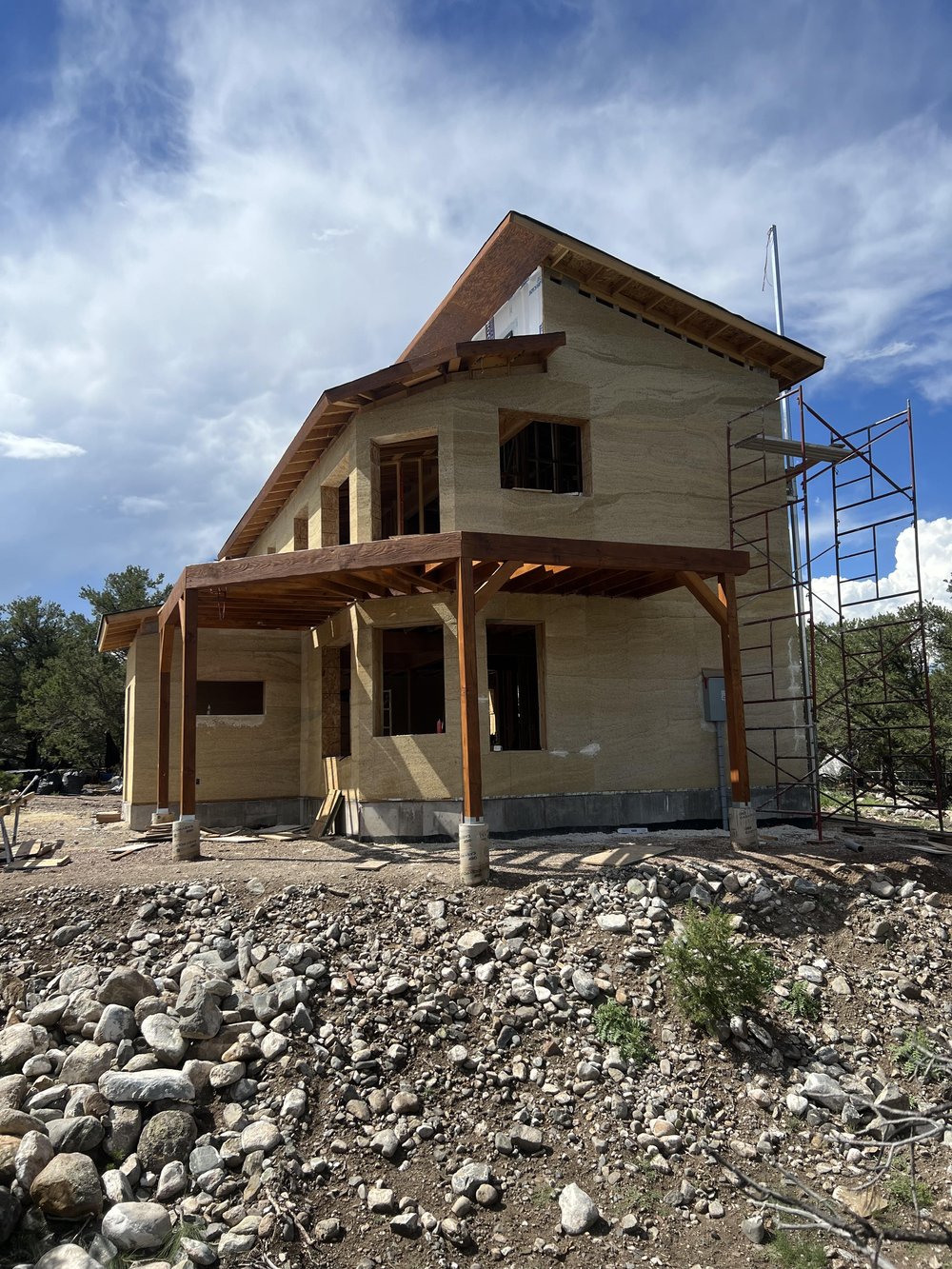

By Jean Lotus
What a difference a year makes! When HempBuild Mag started in spring 2021, every hemp building in the United States was a rarity. Almost all hemp hurds and most binder were imported from Europe, and we could count on one hand the actual folks who were out there constructing houses with hemp.
This year, after the first season of growing fiber strains of hemp domestically, we’re seeing processing plants sprouting up across the country.
And those hempcrete installers who jumped into this industry early – even with a scarcity of materials and skeptical building departments – are generously sharing their knowledge and expertise. It’s a spirit of “co-opetition” – working together and helping each other to build the industry.
Subscribe for HempBuild Magazine’s free newsletter
Come September, things will only get more busy. Hempcrete will be certified in US building codes with an approval into the International Residential Code. A second season of industrial fiber hemp will have been harvested.
What’s driving hemp building? The housing crisis and the appeal of low energy bills and non-toxic living spaces are building consumer demand. And who knows, maybe our first “celebrity” hemp house will be built!
In that spirit, we’d like to introduce you to three new hempcrete builds in Texas, Colorado and Michigan. All three projects began, or were completed, in 2022 and the builders/subcontractors are already starting new projects.
Texas: The Hondo Hempcrete Home
The Hondo, TX Hemp House features a breezeway between the guest quarters, utility room and the main house. Photo courtesy of Texas Healthy Homes
Builder: Tim White, Texas Healthy Homes. Hemp sourced from: South Bend Industrial Hemp, Great Bend KS. Wall assembly: Hand-cast hempcrete in outer and inner walls.
The Hondo house is essentially the benchmark we are aiming for in the building industry. With 2,484 sq ft of usable space, it is a one-story house with a strategically simple design. It features a breezeway between the guest quarters, utility room and the main house which is common vernacular architecture here in the Hill Country.
This particular design, paired with small windows both helps the energy efficiency of the home and brings occupants out of the building so they spend more time connected with outdoor spaces. With grade beams instead of slabs, full adobe floors in the entire home including the breezeway, and natural monolithic cellulose-based wall cavities (hemp, in this case) we address the issues of sustainability the modern building industry struggles with.
To maintain breathability, we use historic lime plasters on the exterior so moisture is always released keeping away mold and rot. Aside from our tadelakt showers, all of our interior finishes are done with American Clay plasters because, like all clay plasters, they help regulate the air quality, temperature and humidity in the home, and unlike home-made clay plasters like so many natural builders are used to making ourselves, American Clay has an incredible array of pre-blended colors and a chart that makes color selection a breeze.
Click here to go to our FREE online community.
The Hondo house features natural clay plaster walls and adobe floors. Photo courtesy of Texas Healthy Homes
-
What were the buyers looking for that caused them to choose Texas Healthy Homes and hempcrete for their project?
In all honesty, it wasn’t what everyone expects. Everyone thinks it must have been the sustainability factor, the sensationalism of hemp or even, our namesake- non-toxic, healthy homes. Nope, it was none of these, it was simply affordability.
-
How long did the project take to complete?
Eight months. And for a home at the end of a 2 mile dirt road 35 minutes away from any town, that’s not bad.
-
Can you tell us a bit about the worksite and the camp/work arrangements?
We set up Hobo Camp because we’ve had to figure out a way to economically facilitate projects that are pretty consistently around 2-5 hours away since there are currently no natural subdivision developments taking place. We hope and anticipate that will soon change and while we are actively looking for investors for a small subdivision, we do enjoy our community set-up in the meantime.
Hobo camp hosts an array of premium overnight facilities like hot outdoor showers and a biodigester for our toilets and food scraps. (Yes, you can cook with the gas this makes). Luxurious, we know… In our common yurt we have the Hobo Mess hall where we join for all meals that we cook together. It’s a real community vibe that we all truly value. Of course while this set-up helps reduce our carbon footprint in more ways than one and it is the most convenient arrangement for our crew, we do understand this kind of lifestyle can create hardships and we are empathetic when a crew member needs space or time off to themselves.
Since our next project involves at least two builds we can expect to see four seasons here so we are picking up our chickens soon and starting some raised beds to get the full effect. Our clients, who will inherit these, are certainly not complaining!
Builder Tim White chats with a visitor at the Hondo open house. Photo courtesy of Texas Healthy Homes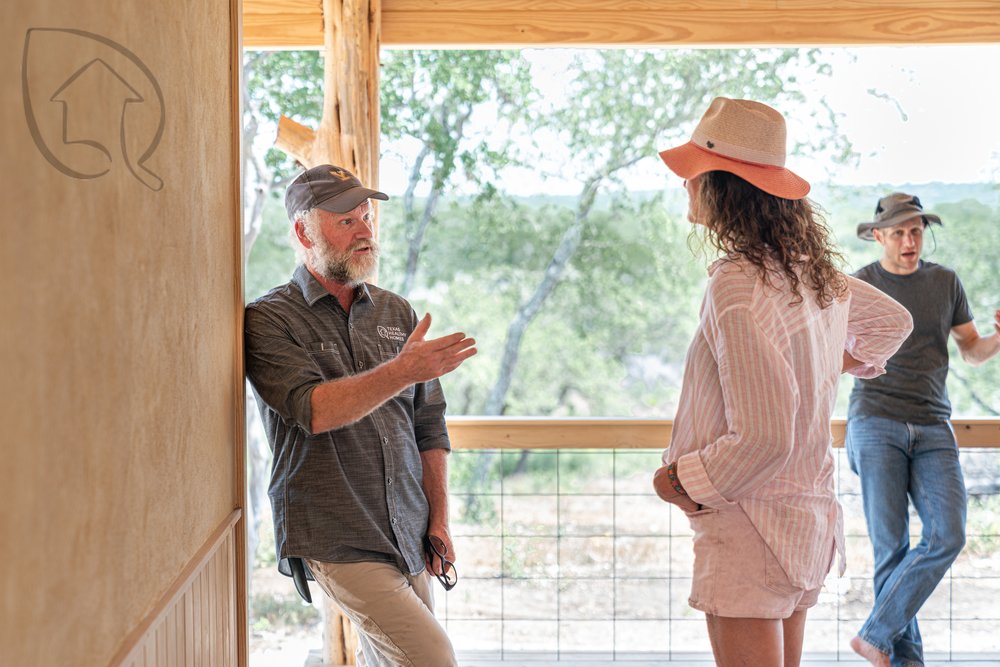
-
Tell us about the blocks you’ve been working on and how those were used on the site?
At THH we understand that in order to build affordable homes and communities accessible to the general public, just to be able to drop our price per square foot, we’ve got to reduce the construction time. This can be achieved with a block. Distinct from the current system of tamping within stick-frame, a block eliminates the lumber, helps with thermal bridging and shaves off a ton of time and labor.
We believe in using the past to build the future so we’ve concluded that a lightweight, load-bearing block based on historic adobe construction is the answer. The Pyramids were built with blocks after all…
-
What’s next?
As for building projects, we have three in the books and several down the pipeline. Two in Wimberly and another in Pipe Creek is being zoned, mapped and prepped for rainwater harvesting, earthworks and permaculture while we are in the design phase.
We have a workshop series scheduled for the fall (6 or 7 weeks, check back in-we will be posting on our website) and are continuing to make connections to translate our building system into products that will make it more accessible and affordable.
A view from the covered porch of the hempcrete house in Hondo, TX. Photo courtesy of Texas Healthy Homes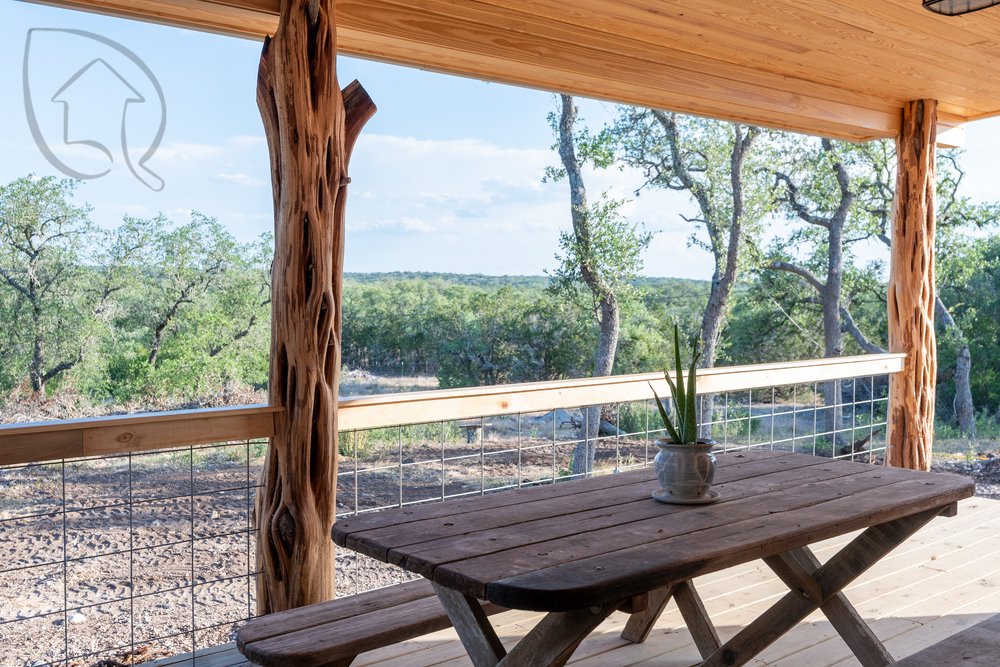
-
Are you still hiring?
We are! As our demand continues to grow we will continue to seek out and train craftsmen. We consider every work day as training because we understand that the breadth and depth of such knowledge is vast and in grave danger of being lost forever. A Texas Healthy Homes craftsman (or woman) will not only learn through instruction but by observation and application. Our staff and crew have a lot of fun together as we are all passionate about this work and we are very-tight knit. We support one-another in both our lives and journeys in becoming craftsmen.
-
What are the successful attributes of a natural builder?
We are honored to be able to work with natural materials. One of the perks of being a natural builder is that you get to use your body, but not abuse it. We use only non-toxic materials and make sure that, with the products we make and use, the workload is light. We are naturally trained to make use of available resources and understand the importance of historical techniques like the lime plaster and clay plaster systems we use.
Understanding that our buildings will last hundreds if not thousands of years we take pride in making things beautiful. You’d be hard-pressed to find a clay plaster finish that wasn’t stunning!! Our goal has always been to make healthy and sustainable homes and we understand that the only truly sustainable building products are natural products – and very few of those are yet on the market. With our system and upcoming product line we are hoping to change that.
Colorado: Howard House
The hempcrete house built at 8,000 feet elevation in Howard, CO is fire resistant and well-insulated to withstand cold winters. Photo courtesy The Hemp Building Company
Hempcrete subcontractors: Phelan Dalton, The Hemp Building Company. Hemp Sourcing: South Bend Industrial Hemp, Great Bend KS. Wall assembly: Hand-cast hempcrete in outer walls.
The Howard House is a two-bedroom, two-bath, 1,600 sq ft. two-story home looking out at a gorgeous view of twin sisters in the Sangre de Christo mountain range. The property is 35 acres and off grid/ off the beaten path.
The homeowner is the builder along with Larry Pygott from Rocky Point Construction (Buena Vista, CO) and they added some very cool features to the house, including stained concrete floors, a spiral staircase, large exposed beams and windows everywhere to bring in the beauty of the area.
The walls are insulated with 12” thick hemp lime (hempcrete) encasing the 2 x 6 studs on a 2-foot center frame. The house is 27 feet tall with a mono-pitch roof insulated with 15” of HempWool with an R-value of 56. The house will be lime plastered on the exterior and earthen plastered on the interior. The owners are planning to leave a wall raw and unplastered to expose the natural beauty of cast-in-place hemplime.
Other features include concrete window sills, a possible tadelakt shower, a HempWood dining table and possibly HempWood floors upstairs and custom concrete sinks.
This owner-designed home is a longtime dream for the family. Photo courtesy of The Hemp Building Company
-
What were the buyers looking for that caused them to choose Hemp Building Co. and hempcrete for their project?
Taylus (the owner) and I had been talking about his project for about a year and we were able to help his family build their dream home. We provided the materials, mixer, labor, and consultative and design services within his budget.
-
How long will the project take to complete?
There is still a lot to do but another couple months and it should be move-in ready. Taylus has big plans for the home so it may not be until next year that he can get around to all the details.
-
Can you tell us a bit about the worksite and the work arrangements?
We were camping for the most part. I brought my converted school bus to sleep in and we had a nice collective camp kitchen. There was only one 220v plug in so we had to switch between my mixer, the owner’s RV and the well-pump to get water. We used a Bobcat to lift hemp lime mixes to the second story and pump jacks and makeshift scaffolding to install the hemp lime in the higher areas.
-
Can you tell us about the area in southwest Colorado and why hempcrete is a good solution there?
Howard is a small town outside of Salida, CO. The Arkansas river runs through it. The property is at 8,000 feet elevation surrounded by mountains on every side. The area is high plains desert so there are many piñon pines, rocky sandy ground and sage. As always, fire is a concern in Colorado so hemp lime with a lime plaster is a great material for maximum resistance to fire.The temperature and humidity regulating properties could already be felt inside the structure halfway through the hemp lime installation and provided relief from the hot dry climate. The thermal performance coupled with the south facing windows and thermal mass will be extremely effective in the colder winter months.
One hempcrete wall will be left unplastered to reveal the natural layers of tinted hemp and lime. Photo courtesy of The Hemp Building Company
-
What’s next after this?
We are doing the garage of a house we will build next year in La Veta, CO. We’re also building an office inside of Global Fiber Processing’s new facility and making blocks at our facility in Lafayette, CO.
Michigan: Chelsea Hemp House
The FiberFort crew celebrate in the window openings of the Chelsea, MI hemp house outside Detroit. Photo courtesy of FiberFort. 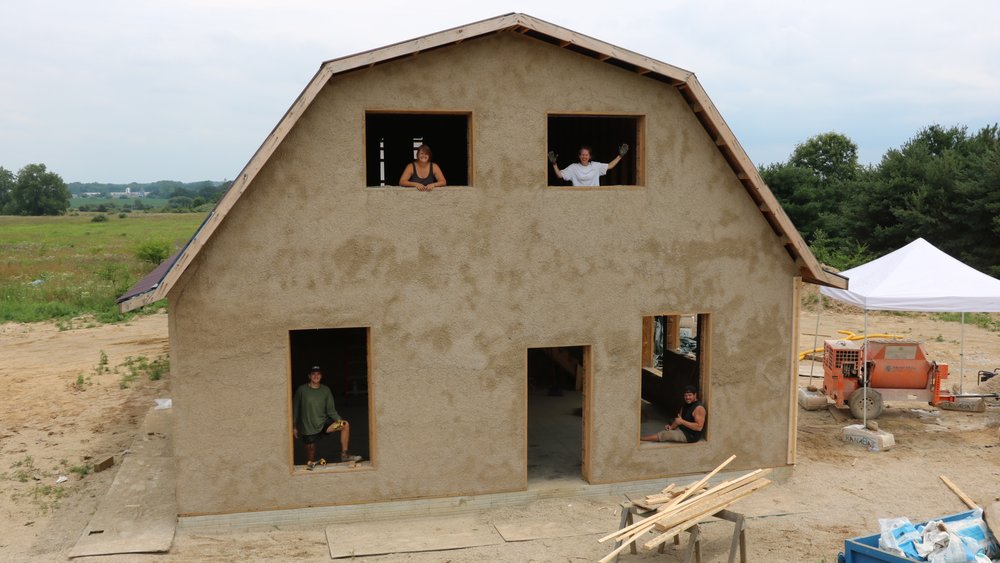
Hempcrete subcontractors: Kim Croes, FiberFort, with assistance from Cameron McIntosh, Americhanvre. Hemp Sourcing: Kanabat (imported from France) sourced from Americhanvre. Wall assembly: Spray-apply with Ereasy system.
The Chelsea house is a combination of a utility space for storage and the living space of 1,350 sq. ft. It’s in the shape of a barn but it has all the amenities a normal house does. It is a two story building and will be outfitted with many green building options such as a composting toilet, pellet-fed stove with a mini split for backup, and solar panels. The owner is thinking of doing interior cob walls and clay plaster with a lime render exterior.
This house is a new build in a very rural area. There is a long dirt road and circle driveway surrounding the house for access. Luckily we didn’t have to deal with much rain. The expansion of the land is incredibly scenic and a perfect place for such an earthy building to be located.
The owners are developers and they are in the process of building a whole community on their 22 acre property. All the buildings will have to follow specific guidelines that adhere to their green initiatives. We met at a hempcrete workshop about a year ago. We talked over the phone and met in person many months later on the jobsite after an out of-the-country option fell through and eventually they chose to trust Fiberfort with this project.
Spray-applied hempcrete insulation took eight days to cover the house. Photo courtesy of FiberFort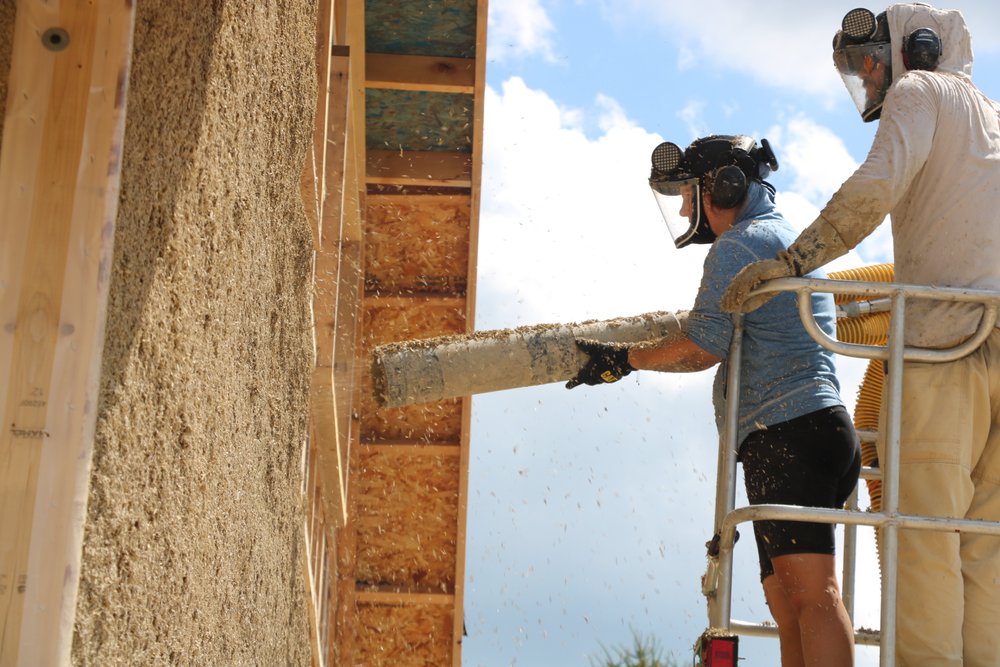
-
How long will the project take?
Our part of the project is mostly complete although there is some screeding left to do. It took us eight days to form, frame, and spray the hempcrete. I am sure it won’t be until spring 2023 before the whole house is completely finished.
-
Can you tell us about the neighborhood in Chelsea and the homes that are being built there?
Chelsea is an eco minded city with a lot of land and a cute little downtown area. Living in Chelsea gives its residents peace and quiet with the luxury of being 20 minutes from a bustling city (Detroit). There are some subdivisions that have begun to take form there but it’s mostly single homes on many acres of land.
The Chelsea House Team: (L-R) Cody Ley, Cameron McIntosh, Stephanie Syzmanski, Vaughn Warren, Kim Croes, Osmund Gray. Photo courtesy of FiberFort
-
What’s next after this?
Now that we have accomplished our goal of building our first hempcrete structure we have had many opportunities arrive. Universities, farm coalitions, home owners, and developers are all interested in what we are doing. We will take what we learned from this build and develop better ways of building these structures in our region.
Fiberfort’s goal is to make as big of an impact as possible and we think we have an amazing opportunity in Detroit. Detroit is full of structures that have been deteriorating for decades. With the spray application method we can help revitalize Detroit in a green way!
Natural building is a very special field. It has a certain association that comes with it and that’s where hempcrete to me is the perfect material. It bridges the gap between natural and modern. Being successful in this field is going to require a lot of alterations. What we came in planning to do is not the same as what we now know we have to do to continue. It takes guts, sacrifice, passion, and a strategic mind in order to make it in this field.
Please Support Our Classified Advertisers
(To find out more about advertising CLICK HERE).
Help Wanted:
Training and Education
Publications
-
Hemp Building Directory 2022 – Guide to the International Hemp Building Industry
-
Available Now! “Hemp Buildings – 50 International Case Studies” by Steve Allin
Hemp Hurd (shivs)/Hemp Fiber/ Hemp Microfiber
Hempcrete installers/Insulation subcontractors
Lime Binder
Hemp Batt Insulation/Supplies
Green Builders
Hemp Building Engineers
Hemp Genetics
Professional Associations
Events
Originally published July 24, 2022 on Hemp Building Mag
https://www.hempbuildmag.com/home/3-hemp-houses


